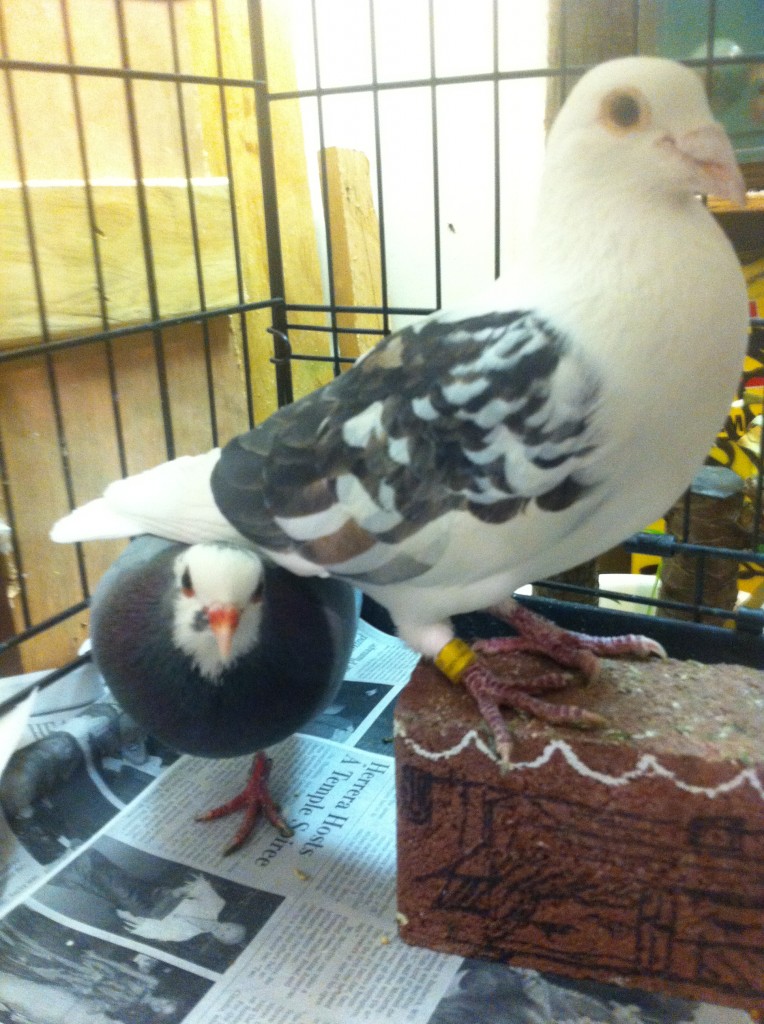Ken, Ben and I love pigeons.
Category Archives: Interspecies
Meeting Pigeons and Their Caretaker
Last night Ben, Ken & I met with a friend who raises and cares for pigeons on the roof of his apartment in Brooklyn. I was struck by how beautiful the birds were compared to feral street pigeons.
Here’s a picture that Ken took of two pigeons preparing to mate. Pigeons mate for life, although they are apparently willing to trade partners if you stick them together alone in a box. The white pigeon is a male, the other female. Both of these pigeons had previous partners who passed on.
More to come soon…
Pigeons of New York
I’ve teamed up with Ken Amarit and Ben Gullard to work on a project about the pigeons of New York. The pigeons we are accustomed to seeing in city streets are the descendants of domesticated rock pigeons, brought to American in the 1600s by settlers, but with a history of human symbiosis that reaches back at least 5000 years. They are considered an invasive species, but are uniquely suited to city life, thriving in urban environments that resemble their original rocky habitation. They live well with humans, succeeding when we do, feeding off our waste, and perhaps as a result are marginalized and maligned by most.
We intend to interview a pigeon trainer in Brooklyn (who wishes to remain anonymous), and will also reach out to Glenn Phillips of the New York City Audubon Society, as well as members of New York City Pigeon Rescue Central.
Our project is still somewhat undefined but we’re interested in investigating new ways for people and pigeons to interact, primarily through play.
Here are some fun facts about pigeons:
- Both males and females incubate pigeon eggs as well as secrete a nutritious fatty milk for their young.
- Pigeons mate for multiple seasons (some say for life).
- In some cities pigeons are given contraceptives.
- In some cities people steal pigeon eggs and replace them with dummy eggs.
- Pigeons are hunted by peregrine falcons, another city transplant.
- Pigeons do not migrate but they have an excellent sense of direction.
- Pigeons can fly at up to 60 miles per hour.
Interspecies project ideas
Here are some links that point in the general direction of what I’m interested in exploring.
Strange animal exploitation for medical use
- The Viagra worm: In the early 1600s, Duke Gonzaga of Mantova, who was syphilitic and suffering from erectile dysfunction sent an apothecary to the New World in search of a miracle worm with viagra-like properties.
- Helminthic therapy
Genetic experiments
- Dog breeding disasters – the dire consequences of breeding dogs for aesthetic outcomes.
- Pig cloning factories in China that take cloning to an industrial scale.
Cross-species communication
- Animal psychics (and others who exploit the longing to overcome the understanding gap for their own profit). Examples: animalstalk.com, charlespeden.com
- The figure of the Extra-terrestrial and especially the difficulty in communicating with other species as depicted in Stanislaw Lem’s Solaris, or Fiasco.
- Interspecies friendship (which happens to be my favorite genre of youtube video)
- BowLingual – a dog-to-human translation device.
- Debates and uncertainties about cross-species communication, friendship, or empathy speak to the deepest solipsistic paranoia over the possibility of any kind of communication at all. Even among ourselves we can never be sure that we are reaching an understanding. On the other hand we might say that bridging the gap is not only possible but constant and it’s only the self-awareness of those communions that is perpetually out of reach.
Human law and animals:
- Medieval animal trials. On Slate and Wikipedia. Animals are thrust into a human legal framework. Is this simple anthropomorphism or is something else at play?
- In a similar vein, the pardoning of the turkey.
- Prison dog programs.
- Military dolphins. What other unexpected animals are militarized?
Speciation
- The process by which new species emerge, or, how a species stops being able to reproduce with itself. I’m imagining a sci-fi future where new human speciation occurs as the inevitable result of rigid class division.
Also here’s an incredible quote from Plutarch on vegetarianism. I’m interested in the shift in perspective (from meal to corpse, or from “them” to “us”) that accompanies this rhetoric.
You ask me upon what grounds Pythagoras abstained from feeding on the flesh of animals. I, for my part, marvel of what sort of feeling, mind, or reason, that man was possessed who was the first to pollute his mouth with gore, and to allow his lips to touch the flesh of a murdered being; who spread his table with the mangled forms of dead bodies, and claimed as his daily food what were but now beings endowed with movement, with perception, and with voice. How could his eyes endure the spectacle of the flayed and dismembered limbs? How could his sense of smell endure the horrid effluvium? How, I ask, was his taste not sickened by contact with festering wounds, with the pollution of corrupted blood and juices?
I’m not entirely sure what project will emerge out of all of this, but here are some ideas:
- A parodic set of experiments or contraptions to militarize unlikely animals (unmanned domestic cat drones, surveillance pigeons etc.)
- A stalinist show trial for bed bugs or other marginalized New York critters.
